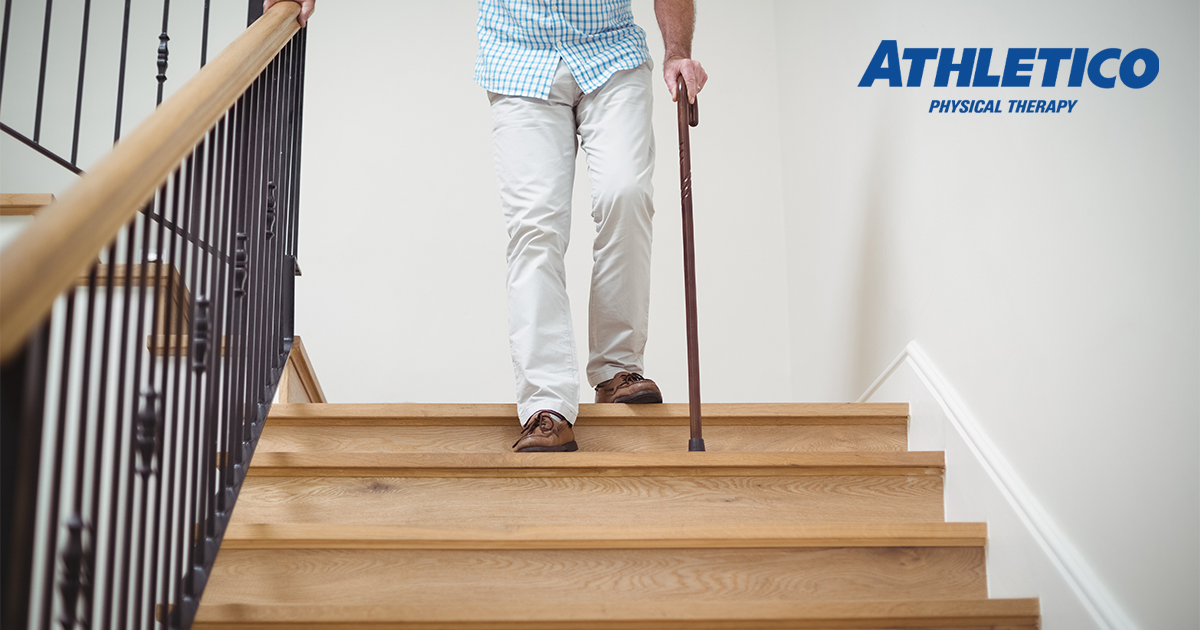Falls can happen anywhere, especially when going up and down stairs. Falls prevention can be done for everyone, regardless of age or ability, to avoid injury both inside and outside the home. Looking for a way to keep you or a loved one safe at home? Listed below are some ways to reduce the risk of falls and injuries on stairs.
“Plan for the best, plan for the worst”
Falling down stairs can be traumatic and sometimes fatal. So it’s important to plan ahead to keep you or your loved ones safe. Have a chair or seating area at the top and bottom (in between, if you can) for the individual to take a breather and rest when needed. It probably won’t be used, but it’s better to be prepared than to fall.
Prepare for a rainy day
If you typically use a cane, crutches, walker, or other assistive device, it may be helpful to plan ahead. If you keep a spare cane, crutches or walker at the top or bottom of the stairs, you will no longer need to carry them when you travel. This will allow you to walk up and down stairs more safely and without mess.
Safety first!
When was the last time you checked your stairs and/or railings? Most public spaces have disability access, but if you’re visiting friends in an older house or apartment, it’s wise to make sure the railing can support your weight or is properly secured to the wall. You can never be too safe, especially when you are planning a large gathering with elderly or infirm clients.
be creative
If you’re carrying a heavy, large, soft item at the top of the stairs and need to move it downstairs, why not throw it at the bottom of the stairs? This can be done with clothing, sheets or even stuffed animals and toys. In order to use the grab bar safely, it is important to keep both hands free. While this technique may not work for every project, it’s important to remember that the “usual way” isn’t always the best way. This could mean wearing a jacket down the stairs instead of carrying it with you, or even putting fragile items in a bag and carrying them on your back to free up your hands.
Efficiency is the key to success
Why go up and down stairs ten times a day to store “one thing” when you can plan ahead and take all ten on one trip? The best way to do this is to place a small box or bag at the bottom or top of the stairs. Take your time slowly filling up the items you need to move over the course of the day, and when it’s full or up to a safe size, you’ll be on your way to a safe and efficient trip. This will help reduce excessive fatigue and shortness of breath; it will also save you energy for the rest of the day.
don’t forget the lighting
As we age, our eyesight and perception of light decline. It is important to maintain bright lighting and good visual contrast to reduce the risk of slips, trips and falls. Another alternative to using lights is to use bright or neon tape around the edge of the steps to provide good visual contrast to ensure that individuals can clearly distinguish the steps. If there is a real visual impairment, then a tactile non-slip tape or a change in surface material can ensure that the individual can safely anticipate changes in slope ahead.
fall hazard zone
The worst kind of fall is an accidental fall. This can be avoided by using doors at the top and/or bottom of the stairwell. Commonly known as “baby gates,” they can also help prevent accidental missteps or loss of balance when we least expect it. It’s also a good reminder to slow down and pace yourself before going up and down stairs quickly. Instead of rushing up and down stairs, take your time and avoid injury so you can enjoy the rest of your day.
Try Visual Grounding
Vertigo is a term that is often thrown around when people feel dizzy while hiking, climbing or even flying at high altitudes. However, even a few steps can be quite intimidating for some people. A technique called visual grounding can help people feel more stable and confident when they feel dizzy or lose their balance. Stare at objects that don’t move (such as outlets, handrails, or light switches) while you’re moving; we do this to train our brains to feel safe, stable, and reduce the risk of falls.
This list highlights some simple solutions to help you and your loved ones stay safe inside and outside the home. For a more patient-specific, personalized plan, contact Athletico and set up a free evaluation for you or a loved one. Free assessments are available in-clinic or virtually through our telehealth platform.
Request a Free Evaluation
*Beneficiaries of programs such as Medicare, Medicaid, Tricare, VHA, and other federally funded programs are not eligible for free evaluations per federal guidelines.
The Athletico Blog is an educational resource written by Athletico staff. Sports bloggers are licensed professionals who abide by the code of ethics set by their respective professional associations. The content published in blog posts represent the opinions of the individual authors based on their expertise and experience. The content on this blog is provided for informational purposes only and does not constitute medical advice nor should it be relied upon in making personal health decisions.
About the author:
Rebecca Pudvah is a triathlete and physical therapist with a passion for helping others achieve their fitness goals. Rebecca is a graduate of Simmons College in Boston, MA with a PhD in Physical Therapy. She is an Orthopedic Clinical Specialist from the American Board of Physical Therapy and a Certified Strength and Conditioning Specialist from the American Strength and Conditioning Association. During her undergraduate studies, she attended the University of Massachusetts Amherst where she earned a BA in Kinesiology while competing in Division I cross country and track. Rebecca loves sharing her knowledge and personal experiences to help those in need through challenging and distressing times. She is passionate about guiding patients to a healthy, positive, pain-free human experience.



